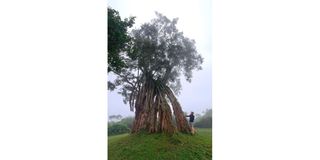A visit to Dedan Kimathi Post Office

The strangler fig tree known as the Dedan Kimathi Post Office in the Aberdares.
I’ve spent many weekends in the Aberdares in recent years, mainly exploring the high tracks in the south of the park. In the past while visiting The Ark or Treetops in the Salient, I would usually come through the Ark Gate in the east via Nyeri and never stray far beyond the lodges.
But having ventured further since, I’ve discovered the beauty of the waterfalls and moorlands in the south and now prefer to approach the park through the Matubio West Gate, via the Nairobi-Nakuru Highway. I followed this route again on a foggy morning last weekend on a short trip with a group of friends.
That morning drive set the tone for what would be a very cold and wet couple of days in the Aberdares. Our first scheduled stop was at EsQoffee – a smart new café on the escarpment with a wide view down into the Rift Valley. But the fog still hadn’t lifted, and the view that we anticipated was obscured by a thick white screen. The weather didn’t put off other customers, though; we chatted to a group of guys who had driven all the way up from Nairobi just for a cup of coffee.
From the café, we continued north and then took a right turn at the flyover beyond Soko Mjinga. The remaining 60km stretch to the Matubio West Gate winds up the Kinangop Plateau through Njabini, Engineer and Nduyu Njeru.
The main advantage of using this entrance to the park is its proximity to the spectacular Karuru and Gura Falls. We followed a short but very muddy and rocky diversion off the main road towards the top of the Karuru Falls, completing the last few hundred metres on foot. Access to this point was improved in 1992 by the British Army’s Royal Engineers, who constructed two sturdy timber viewpoints – one on each side of the four-metre-wide Karuru River.
When we arrived at the first platform, we again faced an impenetrable white wall of fog. I had to describe the scene to the others who hadn’t been there before – of the tall Gura Falls across the yawning canyon below.
Although the wet conditions had screened our view, the rain had also turned the trails to mud and they revealed the tracks of all the animals that had used the path before us. There were signs of buffaloes and hyenas and the tracks of a leopard so fresh that we could make out the dimpled imprints of the soft pads of its paws.
Maguru Falls
After a scenic picnic at the nearby Maguru Falls, we descended the slippery roads into the forested Salient in the east of the park. Along one of the roads, we came across a signpost for the ‘Dedan Kimathi Post Office’ and turned off to explore. At the end of an overgrown track, we emerged into a clearing with a huge strangler fig tree at its centre. Its thick, tangled roots had been smoothed by many years of rubbing by passing elephants.
In the 1950s, the tree was famously used as a communication tool by Mau Mau guerrillas hiding in the caves and forests of the Aberdares led by Field Marshal Dedan Kimathi. The Mau Mau’s ‘Postmaster’, Macharia Nguyo Kanyiri, collected and delivered letters left in the holes of the fig tree by his fellow fighters. Similar ‘post office’ trees were dotted around Mount Kenya and other Mau Mau forest strongholds.
Today, a weathered plaque at the base of the tree commemorates the day it was made a national monument. It would be useful to have an information board detailing the history of the tree and the Aberdares in the context of the Mau Mau uprising, rather than a few words honouring the dignitary who opened it to the public. But it’s great to see that the tree is being protected, and that its significance for Kenya’s history is recognised.
Email: [email protected]




